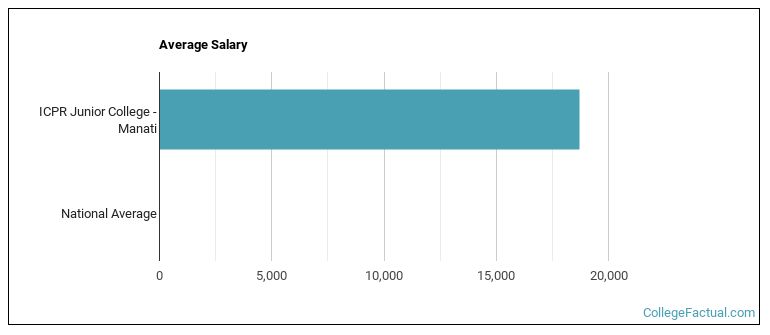 by our College Data Analytics Team
by our College Data Analytics TeamExplore the best ranked schools for the programs you are most interested in.
ICPR Junior College - Manati was not ranked in College Factual's Best Overall Colleges report this year. This may be because not enough data was available.
Since ICPR Junior College - Manati has an open admissions policy, being accepted to the school isn't that hard. However, a full basic things - such as a high school diploma or equivalent - may be required. Also, go over your application to make sure it is complete before you submit it.
The student to faculty ratio at ICPR Junior College - Manati is 21 to 1, which is high when compared to the national average of 15 to 1. This may indicate that some of your classes will be larger in size than they would be at other schools. However, upper level classes will probably be smaller.
When estimating how much access students will have to their teachers, some people like to look at what percentage of faculty members are full time. This is because part-time teachers may not have as much time to spend on campus as their full-time counterparts.
The full-time faculty percentage at ICPR Junior College - Manati is 46%. This is comparable to the national average of 47%.
The freshmen retention rate tells us what percentage of first-year, full-time students choose to continue on to their sophomore year at a particular school. The rate at ICPR Junior College - Manati is 63%, which is about average when compared to the national rate of 68%.
During the 2017-2018 academic year, there were 346 undergraduates at ICPR Junior College - Manati with 292 being full-time and 54 being part-time.
The net price is calculated by adding tuition, room, board and other costs and subtracting financial aid.Note that the net price is typically less than the published for a school. For more information on the sticker price of ICPR Junior College - Manati, see our tuition and fees and room and board pages.
While almost two-thirds of students nationwide take out loans to pay for college, the percentage may be quite different for the school you plan on attending. At ICPR Junior College - Manati, approximately 2% of students took out student loans averaging $5,000 a year. That adds up to $20,000 over four years for those students.
Get more details about paying for ICPR Junior College - Manati.

See which majors at ICPR Junior College - Manati make the most money.
Get more details about the location of ICPR Junior College - Manati.

Contact details for ICPR Junior College - Manati are given below.
| Contact Details | |
|---|---|
| Address: | Carretera #2 K.M. 49.9 Puerta Del Norte Mall 4To. Piso Suite 17, Manati, PR 00674 |
| Phone: | 787-884-6000 |
| Website: | www.icprjc.edu/ |
| Most Popular Majors | Bachelor’s Degrees | Average Salary of Graduates |
|---|---|---|
| Culinary Arts | 41 | NA |
| Homeland Security | 26 | NA |
| Health & Medical Administrative Services | 23 | NA |
| Computer Software & Applications | 15 | NA |
| Human Development & Family Studies | 15 | NA |
| Nursing | 12 | NA |
| Allied Health Professions | 11 | NA |
| Somatic Bodywork & Therapeutic Services | 11 | NA |
| Electronics Maintenance & Repair | 7 | NA |
| Health Aids/Attendants/Orderlies | 3 | NA |
Online courses area a great option for busy, working students as well as for those who have scheduling conflicts and want to study on their own time. As time goes by, expect to see more and more online learning options become available.
In 2022-2023, 32 students took at least one online class at ICPR Junior College - Manati. This is an increase from the 2 students who took online classes the previous year.
| Year | Took at Least One Online Class | Took All Classes Online |
|---|---|---|
| 2022-2023 | 32 | 32 |
| 2021-2022 | 2 | 0 |
| 2020-2021 | 346 | 346 |
| 2018-2019 | 6 | 2 |
Learn more about online learning at ICPR Junior College - Manati.
Footnotes
*The racial-ethnic minorities count is calculated by taking the total number of students and subtracting white students, international students, and students whose race/ethnicity was unknown. This number is then divided by the total number of students at the school to obtain the racial-ethnic minorities percentage.
References
More about our data sources and methodologies.